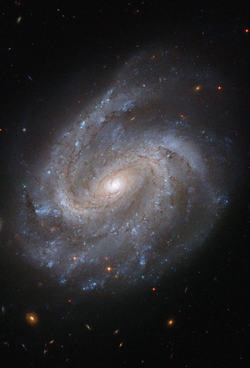NGC 201
| NGC 201 | |
|---|---|
 Hubble Space Telescope image of NGC 201 | |
| Observation data (J2000 epoch) | |
| Constellation | Cetus |
| Right ascension | 00h 39m 34.820s[1] |
| Declination | 00° 51′ 35.60″[1] |
| Redshift | 0.014728 +/- 0.000062 [1] |
| Heliocentric radial velocity | 4415 +/- 19 km/s [1] |
| Galactocentric velocity | 4505 +/- 19 km/s [1] |
| Distance | 61.7 ± 4.3 kpc (201 ± 14 kly)h−1 0.73 [1] |
| Apparent magnitude (V) | 13.8 [1] |
| Characteristics | |
| Type | SAB(r)c [2] |
| Size | 163,230 ly (50.07 kpc) (estimated)[1] |
| Apparent size (V) | 1.8' x 1.5' [2] |
| Other designations | |
| PGC 2388, UGC 419, MCG +00-02-115, HCG 007C | |
NGC 201 is a spiral galaxy in the constellation of Cetus. It is one of the group members of HCG 7, with the other group members NGC 192, NGC 196, and NGC 197. It was discovered on December 28, 1790 by William Herschel.[2]
One supernova has been observed in NGC 201: SN 2019yc (type IIb, mag. 16.7) was discovered by Kōichi Itagaki on 22 January 2019.[3]
See also
[edit]Image gallery
[edit]References
[edit]External links
[edit] Media related to NGC 201 at Wikimedia Commons
Media related to NGC 201 at Wikimedia Commons- NGC 201 on WikiSky: DSS2, SDSS, GALEX, IRAS, Hydrogen α, X-Ray, Astrophoto, Sky Map, Articles and images
- SEDS


 French
French Deutsch
Deutsch
